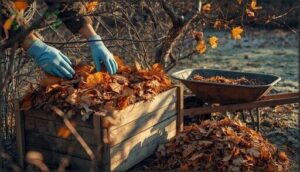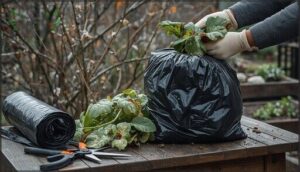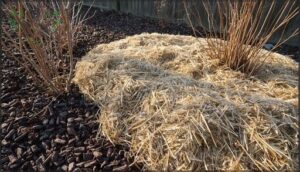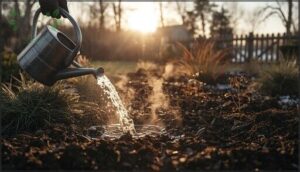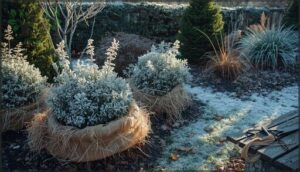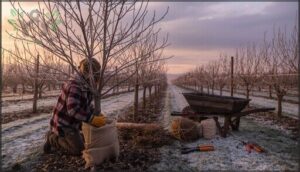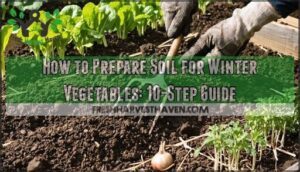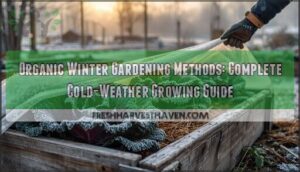This site is supported by our readers. We may earn a commission, at no cost to you, if you purchase through links.

The difference between a garden that bounces back vigorously and one that limps through April often comes down to what you do in these final weeks before dormancy sets in. Getting your winter garden dormant season prep right means working with your hardiness zone’s timeline, protecting what needs shelter, and setting up conditions that actually improve your soil while you’re inside drinking hot cocoa.
Here’s how to send your garden into winter ready to thrive when warmth returns.
Table Of Contents
- Key Takeaways
- When to Start Winter Garden Prep
- Cleaning and Clearing The Garden
- Protecting Soil During Dormancy
- Watering and Moisture Management
- Winterizing Perennials and Shrubs
- Caring for Annuals and Tender Plants
- Preparing Fruit Trees and Berry Patches
- Managing Garden Tools and Infrastructure
- Planning for Spring and Next Steps
- Frequently Asked Questions (FAQs)
- What are winter gardening guidelines?
- What is winter gardening?
- Should you prepare your garden beds for winter?
- How to prepare garden soil for winter?
- How do you prepare a garden for winter?
- How do I succeed in winter gardening?
- How do I protect garden structures from snow?
- Can I add amendments to frozen soil?
- Should I leave seed heads for wildlife?
- What pests overwinter in my garden beds?
- Conclusion
Key Takeaways
- Timing your winter prep by hardiness zone (Zones 3-4 in early September, Zones 5-6 in late September, Zones 7-8 in mid-to-late October) and monitoring first frost dates—which now arrive 11 days later than fifty years ago—gives you the window to protect roots, prevent erosion, and interrupt pest cycles before dormancy locks in.
- Protecting soil through 2-4 inches of organic mulch, tarps for wind and frost barriers, or planting cover crops like winter rye creates insulation that conserves moisture, prevents compaction, and enriches soil health while you’re indoors.
- Deep watering 24-48 hours before a hard freeze, combined with mulching around root zones and using frost blankets or cloches on tender plants, shields roots from freeze-thaw heaving and keeps soil temperature steady through winter’s wild swings.
- Cleaning and sharpening tools, draining and storing hoses, repairing beds and fencing, and keeping a winter garden journal transforms downtime into a strategic advantage—gardeners who document patterns improve spring timing by 25% and catch structural failures before freeze-thaw damage hits.
When to Start Winter Garden Prep
Getting your garden ready for winter starts with knowing the right time to begin. There are a few key things you’ll want to look for as the season shifts.
Here’s what to watch for as you plan your garden’s next steps.
Timing for Different Zones
Before you pull on your boots, check your USDA Hardiness Zone Map—because timing is everything. Recent climate trends mean winter prep for hardy winter crops, planting dates, and frost protection techniques now shift by zone. For example:
- Zones 3–4: Start early September.
- Zones 5–6: Target late September.
- Zones 7–8: Mid to late October.
Understanding the new hardiness zone map is essential for gardeners. Stay nimble as temperature zones warm!
Monitoring First Frost Dates
If there’s one thing garden folklore and science agree on, it’s this: keeping tabs on first frost dates is game-changing for winter prep. Climate shifts skew these timelines—most U.S. cities now see frost 11 days later than fifty years ago. Understanding frost date trends is essential for garden planning.
Here’s a quick comparison to guide your Frost Date Trends and prep:
| Location | Average First Frost |
|---|---|
| Duluth, MN | September 30 |
| Alabama | October 11–Nov 30 |
| Illinois | Sept 21–Nov 10 |
| Coastal/Urban | Later than rural |
Assessing Plant and Soil Readiness
Spotting your first frost means it’s time to check if your soil and plants are truly ready for winter. Is the soil loose, moist, and covered? Are your plants showing signs of hardening off? Keep these in mind:
- Watch out for soil erosion.
- Check plant hardiness.
- Inspect root health.
- Test nutrient levels.
- Gauge frost tolerance.
Cleaning and Clearing The Garden
Before winter digs in, it’s time to tidy up and clear out what your garden won’t need. A little effort now goes a long way in keeping pests and trouble at bay.
Here’s what you’ll want to tackle as you clean and prepare your beds for the quiet season ahead.
Removing Plant Debris
Think of garden cleanup as resetting the stage for spring’s stars. Clearing plant debris after a hard frost isn’t just Debris Disposal; it’s essential Winter Cleanup.
You’ll disrupt overwintering pests, boost Soil Aeration, and keep last year’s diseases at bay. Aim for Disease Prevention without wrecking Ecosystem Balance—toss healthy debris in the compost, but remove diseased material far from your pile.
Managing Fallen Leaves
Under spreading branches, those fallen leaves aren’t just Plant Debris—they’re gold for Soil Enrichment and Wildlife Habitat. Instead of sending Yard Waste to landfill, give back:
- Shred leaves for Mulch or Compost
- Layer as organic materials for Leaf Decomposition
- Blend with grass for balanced Mulching Techniques
- Leave some for sheltering pollinators and birds
Disposing of Diseased Material
Vigilance is your best ally: when dealing with diseased plant debris, act quickly and confidently to cut disease cycles short. Bag and remove infected material—never compost it unless you can guarantee hot composting above 140°F for true pathogen control.
Prioritize sanitation practices and strict waste management throughout your winter garden maintenance to protect soil health and guarantee effective disease prevention.
Protecting Soil During Dormancy
Your soil works hard all year, so giving it the right protection during winter really matters. As the temperatures drop, it’s time to think about keeping that ground healthy and in place.
Here are some practical ways you can shelter your garden beds until spring.
Mulching Techniques for Insulation
Ever notice how a warm blanket makes all the difference on a cold night? That’s exactly what mulch does for your garden beds.
For best winter protection, lay down 2–4 inches of organic mulch—think shredded leaves, straw, or bark. This depth gives your soil insulation, conserves moisture, and helps in frost prevention, steadily protecting plants from cold snaps and temperature swings.
Using Tarps and Covers
Picture soil insulation like a cozy shield—protective coverings such as heavy-duty tarps or frost cloth trap warmth just where it’s needed. Smart cover strategies block whipping winds, prevent erosion, and stop frost from sneaking in.
Choose tarp materials with care: clear plastic for extra heat, or breathable fabric for self-regulating winterizing, both boost winter mulching and heighten frost protection without fuss.
Planting Cover Crops
Think of planting cover crops as weaving a living blanket for winter garden preparation. Your choices in Cover Crop Selection—like winter rye or oats—deliver soil enrichment and erosion control right through the dormant season.
Winter sowing isn’t just routine; it’s strategic crop rotation, shielding soil health while you winterize your garden and prime it for vigorous spring growth.
Preventing Erosion and Compaction
Soil stabilization in winter is like tucking your garden in under a protective quilt. With smart Mulch Application and tarping, you create an effective barrier against Erosion Control headaches and Compaction Prevention woes. Simple Winterization Techniques make a world of difference for soil health come spring.
- Lay at least 2-3 inches of mulch
- Use tarps on heavy, bare soil
- Walk on boards, not beds
Watering and Moisture Management
Keeping your garden hydrated through winter takes a little strategy and timing. The right moisture levels help plants and soil ride out the cold safely. Here’s what you’ll want to keep in mind as you prepare for the season ahead.
Final Watering Before Freeze
A single, deep watering 24–48 hours before a hard freeze gives your plants a fighting chance—especially in winter gardening. Aim for water penetration to reach six inches deep, which boosts root insulation and freeze protection.
Moist soil holds heat, helping shield roots from frost damage. Don’t forget: morning’s best, and always target the base for even soil moisture.
Preventing Soil Dry-Out
Right after that last deep winter watering, your job isn’t done—now’s the time to lock in soil moisture. Layer straw or grass mulch to double your soil’s water content and stretch winter irrigation further.
Organic mulch benefits shine here, but boosting with soil amendments or cover cropping works too. That simple habit keeps your garden’s soil health right where you want it.
Protecting Against Frost Damage
Once you’ve locked in moisture, it’s time to shield your garden with real frost damage prevention. Guard every corner—blanket your beds with winter mulching, tuck plants into cold frames, or wrap roots for soil insulation. Freeze protection methods can be simple:
- Use frost blankets at dusk
- Anchor covers tightly
- Insulate with straw
- Move pots under shelter
Winterizing plants means fewer spring regrets.
Winterizing Perennials and Shrubs
Once winter rolls in, your perennials and shrubs need a little extra attention to make it through the cold. There are a few simple ways to keep them safe and comfortable until spring returns.
Here’s what you can do to give these garden staples their best shot over the dormant months.
Mulching Around Root Zones
Want roots to thrive come spring? Mulch isn’t just a cozy blanket—it’s essential root insulation that locks in soil temperature and guards against wild winter swings. Apply organic mulch in a 2-4 inch layer, keeping it away from crowns.
You’ll boost moisture retention, keep erosion at bay, and lay the groundwork for healthy root growth and resilient soil health.
Pruning Guidelines for Dormancy
A sharp set of pruning tools is your best companion for winter trimming. Prune timing matters—late fall through early spring is ideal.
During the dormant season, prune to shape your plants, target dead or diseased wood, and prevent crossing branches. Clean, angled dormant cuts outside the branch collar encourage healthy regrowth.
Proper winter pruning sets the stage for vigorous spring growth.
Caring for Annuals and Tender Plants
Some plants just can’t handle the winter chill on their own. If you want your annuals and tender favorites to return strong next year, a little extra attention goes a long way.
Here are some tried-and-true ways you can keep them safe until spring.
Lifting and Storing Tender Bulbs
Ever notice how the heart of your summer garden rests underground? For tender bulb care, timing is everything—dig up tender bulbs like dahlias or cannas right after that first frost. Gently lift, trim stems, cure them in a dry, airy spot, and store using my favorite bulb storage tips.
Smart winter garden preparation keeps next year’s blooms strong.
Bringing Sensitive Plants Indoors
Sanctuary—that’s what sensitive plants crave when fall’s chill creeps in. You’ll want to bring frost-sensitive outdoor plants indoors long before temps dip below 50°F, because Indoor Lighting, Plant Acclimation, and Humidity Control all matter.
To keep pest management and temperature adjustment in check:
- Save your prized coleus from frost.
- Protect tender annuals.
- Bring frost-sensitive fruit trees indoors.
Using Frost Blankets and Cloches
Think of frost blankets and cloches as your garden’s extra quilt and cozy hat—a real game changer for winter insulation and frost protection. Lay a breathable blanket across crops or pop a cloche over low growers to keep soil temperature steady and plants healthy.
Here’s how their strengths stack up:
| Frost Blankets | Cloches |
|---|---|
| Shields broad areas | Targets single plants |
| Raises soil temperature | Speeds germination |
| Multipurpose, flexible | Portable, reusable |
| Great for microclimates | Mini cold frames |
Preparing Fruit Trees and Berry Patches
Fruit trees and berry patches need a little extra attention if you want them to bounce back strong in spring. Before the cold really sets in, there are a few smart ways you can keep roots safe and branches healthy.
Here’s what to think about as you prep for winter.
Mulching and Root Protection
Did you know a simple layer of mulch could be the difference between root survival and winter loss? To keep your fruit trees and berries thriving, focus on:
- Choosing mulch materials for ideal root insulation
- Maintaining steady soil temperatures
- Boosting organic matter for soil health
- Ensuring true frost protection with thick, even mulching
Your roots will thank you come spring!
Winter Pruning for Tree Health
Imagine this: winter pruning is your secret weapon for protecting trees and setting the stage for a bumper crop. With sharp eyes and careful tree inspection, focus on Dormant Pruning—removing deadwood, crossers, and problem limbs. Tackle Branch Removal while the tree is resting, so winter wounds heal fast and cut disease risk.
Here’s your winter pruning cheat sheet:
| Pruning Techniques | Why It Matters |
|---|---|
| Dormant Pruning | Less risk of disease |
| Careful Tree Inspection | Spots hidden branch flaws |
| Targeted Branch Removal | Prevents storm breakage |
| Quick Winter Wounds Heal | Faster callusing |
| Strategic Cuts | Boosts spring growth |
Managing Garden Tools and Infrastructure
Your garden isn’t the only thing that needs some attention before winter settles in. Taking care of your tools and patching up your garden’s infrastructure now saves headaches down the line.
Here’s what you’ll want to tackle before the cold really takes hold.
Cleaning and Storing Tools
When winterizing garden tools, start by scrubbing away sap and soil. Clean your tools after every use to slash disease risk.
Tool sanitizing with alcohol or bleach, then thorough drying, wards off trouble.
For rust prevention, oil them lightly and tuck them into a dry, organized space using smart storage strategies.
Sharpening techniques keep pruning shears and spades slicing smoothly next season.
Winterizing Garden Hoses
After tending to your tools, don’t overlook your hoses—a tangled, forgotten garden hose can spell big trouble come spring. Disconnect every garden hose, drain it thoroughly, and coil it gently for Winter Storage.
Hose Insulation or simply storing hoses indoors shields against Frost Damage and is one of the last, essential steps in protecting your garden from cold.
Repairing Beds and Fencing
Once your hoses are tucked away, inspect your raised Garden Beds and fencing for cracks or loose Fence Post Repair needs—winter’s freeze-thaw cycles cause up to 60% of structural failures. Tighten screws, seal wood seams, and shore up wobbly posts now for effective Winter Damage Prevention.
Clean up your Garden Beds by removing debris, then apply mulch for Winter Protection around frames. These Garden maintenance tasks strengthen Garden Structure Reinforcement and support Soil Erosion Control before dormancy.
Planning for Spring and Next Steps
Winter garden prep isn’t just about wrapping things up—it’s also about looking ahead. The quiet months give you time to reflect on what worked, what flopped, and what you want to try next season.
Here’s how to turn your downtime into a launchpad for spring success.
Setting Garden Goals
You can’t improve what you don’t plan. Set goals now for your winter garden prep and next year’s planting season—over 82% of gardeners using SMART gardening frameworks finish tasks faster and see better outcomes.
Write down what you want: more cold-hardy species, better resource management, or productive winter projects. Goal-oriented seasonal planning isn’t just organized—it’s proven to boost spring success by 29%.
Keeping a Winter Garden Journal
A simple notebook can transform your winter garden prep. Journaling benefits go beyond data tracking—over 78% of gardeners identify performance patterns through consistent entries, while 54% report mental health improvements during dormant months.
A simple garden notebook transforms winter prep, helping over 78% of gardeners spot patterns and boosting mental health for more than half
Digital adoption is rising fast, with 44% now using apps for garden planning. Document frost dates, soil conditions, and maintenance tasks. You’ll improve spring timing by 25% and boost gardening confidence year-round.
Frequently Asked Questions (FAQs)
What are winter gardening guidelines?
Winter gardening guidelines focus on protecting plants and soil through dormancy preparation. Think soil insulation with mulch, strategic watering before freezes, proper pruning timing, and plant protection using covers to guarantee spring success.
What is winter gardening?
Cool-season crops and hardy plants thrive when you cultivate them through cold weather—that’s winter gardening. You’re extending harvests with frost protection while maintaining soil temperature, unlocking fresh produce and nutritional benefits year-round.
Should you prepare your garden beds for winter?
Yes, absolutely. Preparing garden for winter protects soil health, reduces pest pressure, and sets you up for spring readiness.
Neglecting winter prep leads to erosion, nutrient loss, and weakened plants—making the time investment worthwhile.
How to prepare garden soil for winter?
Many gardeners skip fall soil care, thinking frozen ground needs no attention. Actually, preparing soil now—testing nutrients, adding compost, mulching for insulation, and preventing compaction—sets you up for healthier plants and better harvests come spring.
How do you prepare a garden for winter?
Preparing your garden for winter involves a thoughtful sequence of tasks: clearing debris, protecting soil with mulch or cover crops, winterizing perennials, safeguarding tender plants, and maintaining tools—all essential dormancy preparation steps.
How do I succeed in winter gardening?
Winter gardening techniques like cold frame success and winter crop selection demand attention to soil temperature, microclimate management, and protecting plants from cold.
Smart pest control and winter plant care guarantee thriving cold weather harvests year-round.
How do I protect garden structures from snow?
Heavy snow stresses garden structures through moisture, weight, and corrosion. Reinforce frames to handle snow loads, apply protective coatings for winter protection, and remove accumulation weekly during storms. Inspect regularly to catch damage early and prevent costly repairs.
Can I add amendments to frozen soil?
Adding amendments to frozen soil isn’t ideal—frozen ground blocks proper incorporation and slows microbial activity dramatically.
Wait until soil temperature rises and thaws for better amendment timing, ensuring nutrients integrate effectively for peak soil health.
Should I leave seed heads for wildlife?
Absolutely—seed heads offer wildlife benefits by providing high-energy food for birds and winter habitat for beneficial insects.
This eco-friendly gardening practice fosters biodiversity and maintains your garden ecosystem while protecting pollinators naturally.
What pests overwinter in my garden beds?
Ever wonder where those spring pests come from? Overwintering sites in your garden beds harbor numerous garden insects—larvae, eggs, and adults—in soil, plant debris, and mulch.
Understanding pest life cycles and cold tolerance helps with winter pest identification and disease management.
Conclusion
Right as you finish your final dormancy task, the first real freeze will probably arrive—and that’s exactly when you’ll appreciate the work you put in. Your winter garden dormant season prep isn’t just protection; it’s a strategic investment in next year’s abundance.
Protected roots, nourished soil, and properly stored tools mean you’re not starting from scratch when the thaw comes. You’ve built resilience into every layer, and spring will prove it.
- https://www.tpslab.com/optimizing-your-soil-for-winter
- https://ucanr.edu/node/116022/printable/print
- https://agrilifetoday.tamu.edu/2024/10/16/five-steps-to-prepare-your-garden-for-winter/
- https://sloatgardens.com/why-do-gardeners-use-dormant-sprays/
- https://www.trianglegardener.com/managing-plant-disease-in-the-cold-months-of-winter/


